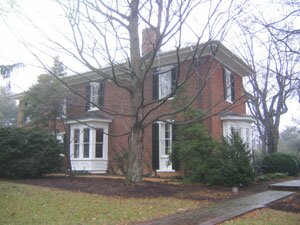REAL ESTATE- On the Block To pine for: Details mark Staunton beauty
ADDRESS: 201 Edgewood Road
NEIGHBORHOOD:
StauntonASKING: $1,350,000
CITY ASSESSMENT: $433,760
YEAR BUILT: 1870
SIZE: 6,000 fin. sq. ft., 1,000 unfin. sq. ft.
LAND: 2.85 acres
CURB APPEAL: 9 out of 10
LISTED BY: Brenda Canning of ReMax Advantage 540-294-2768
These days when demographic stats indicate that Americans move every five years, it's interesting to speculate why people end up where they do.
While waiting in her office for the agent, we eavesdropped as several prospective new Stauntonians talked about their reasons for relocating to the Queen City. A man in his 60s, having attended a nearby military school as a youth, said he'd long dreamed of returning to the Shenandoah Valley. Now retired, he's looking for a new maintenance-free place to unwind and enjoy life.
A woman said she was looking for a city midway between her daughter in Atlanta and her son in Boston. Unlike the retiree, history and charm are her requirements, and Staunton seemed to fill both bills.
Neither of those folks will be looking at this Civil War-era property, for obvious reasons, but whoever does buy it will probably have some things in common with them– an interest in history, a preference for a location convenient to urban centers but with all the (nowadays rare) charms of a cohesive small community, and the desire to enjoy day-to-day living in beautiful surroundings.
The current owners relate the house's history with pride. In its nearly 150-year existence, it's had only three owners. The Ast family built the house and owned it until 1950, when they sold it to a family named Hanna. They made some necessary upgrades and stayed another 50 years. The current owners are, however, breaking the string. They bought it as a flipping project and are moving on to the next one after only five or six years.
But from the look of the place, they've made the most of their short tenure. The house seems to be in A-1 condition. New windows in the large family room/den (a former porch that must have been a marvel) replace '50s-era sliding glass doors and provide views to a big, green (even in bleak midwinter) sloping back garden. Like other changes and additions, the windows complement the sensibilities of the original house. And bright white interior shutters that cover other windows and doors– some louvered and some solid– even though newly custom-made, also reinforce the feeling of antiquity.
For necessary repairs and maintenance of the 6"-wide heart-pine floors, the owners wisely opted to continue with the original easily scuffed varnish instead of choosing modern polyurethane's high-gloss toughness. Likewise, a huge two-car garage addition, while not brick, was designed for compatibility with the house. With its high exposed-rafter roof, it's almost a work of art in itself.
As usual with a house of this vintage, the walls seem to be a foot thick or more, even interior walls, and beautiful fireplaces grace many of the rooms. An elaborately carved brown marble mantel in a "parlor" just inside the front door would be breathtaking anywhere, but here it coalesces with the other striking elements– wide crown molding and chair rails (not just here, but in every room), deep windows, high ceilings, and built-in bookcases– to create an overall impression of authenticity and beauty.
Several things about the house set it apart from others of the era: the original summer kitchen, several steps from the back door, and connected by a brick portico, has been converted to an office with pine paneling. "Yikes!" you're thinking, "pine paneling in a house like this?" Yes, but this is real pine paneling as it's supposed to be– thick, foot-wide panels from trees the like of which won't be seen again. With its big fireplace, it's a room worthy of Williamsburg.
The heating system in the house is unusual and appealing– it's some sort of baseboard system that provides moist hot-water/steam heat without big cast-iron radiators taking up space under every window.
The one place where the renovations chafe is the master suite. Two staircases lead to the second level, one from the back hall in addition to the main flight. At the top of each is a landing, creating a funny little do-si-do of up-and-down. A bedroom and bath up one of the second short sets of stairs are separate enough from the other three bedrooms to create a private guest suite.
Other steps lead to the door of the master bathroom, with requisite Jacuzzi, separate shower and W.C., and connecting door to the master bedroom– not the biggest bedroom, oddly enough. Locating the bathroom right at the top of the stairs was weird– or maybe it's just having the huge tub so close to the door and thus the hall that disconcerts.
Other major renovations added long brown granite counters to the kitchen, along with high-end stainless steel appliances and an intricate tiny-tile white floor with a simple black medallion-like center design– interesting, if, like the bathroom, slightly off-kilter. The owners left the Hanna family's gray tile walls in the large adjoining laundry room, perhaps as a reminder to new owners of how lucky they are that these folks took the place in hand.
The Staunton real estate market being something of an evolving mystery, it's not clear how this house compares to others on the market there. Certainly, like Danville and Lynchburg, Staunton has an impressive inventory of historic houses, but it's doubtful that many have had the treatment this one has.
Well-heeled families casting about for a striking residence– who want the slower pace of Valley life and can find help to maintain the sweeping, park-like grounds– might consider becoming the next residents of this fine old place– and plan to stick around for a while.



#